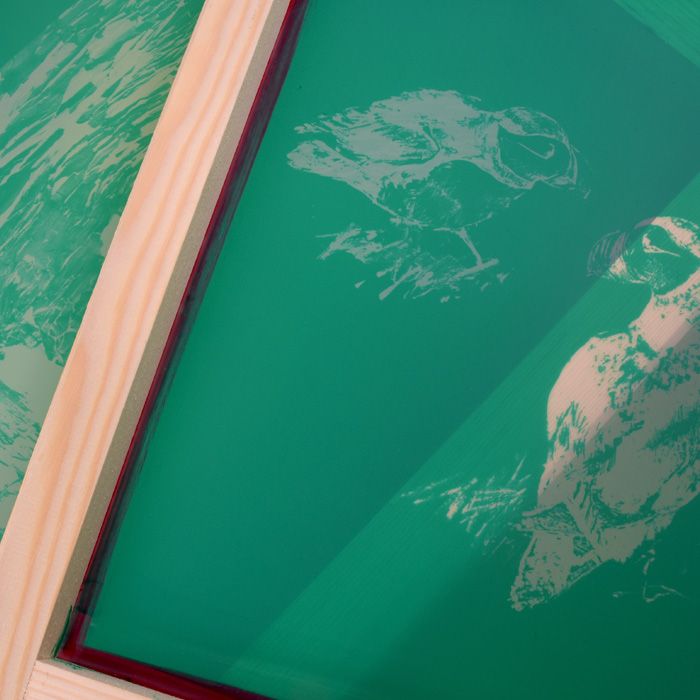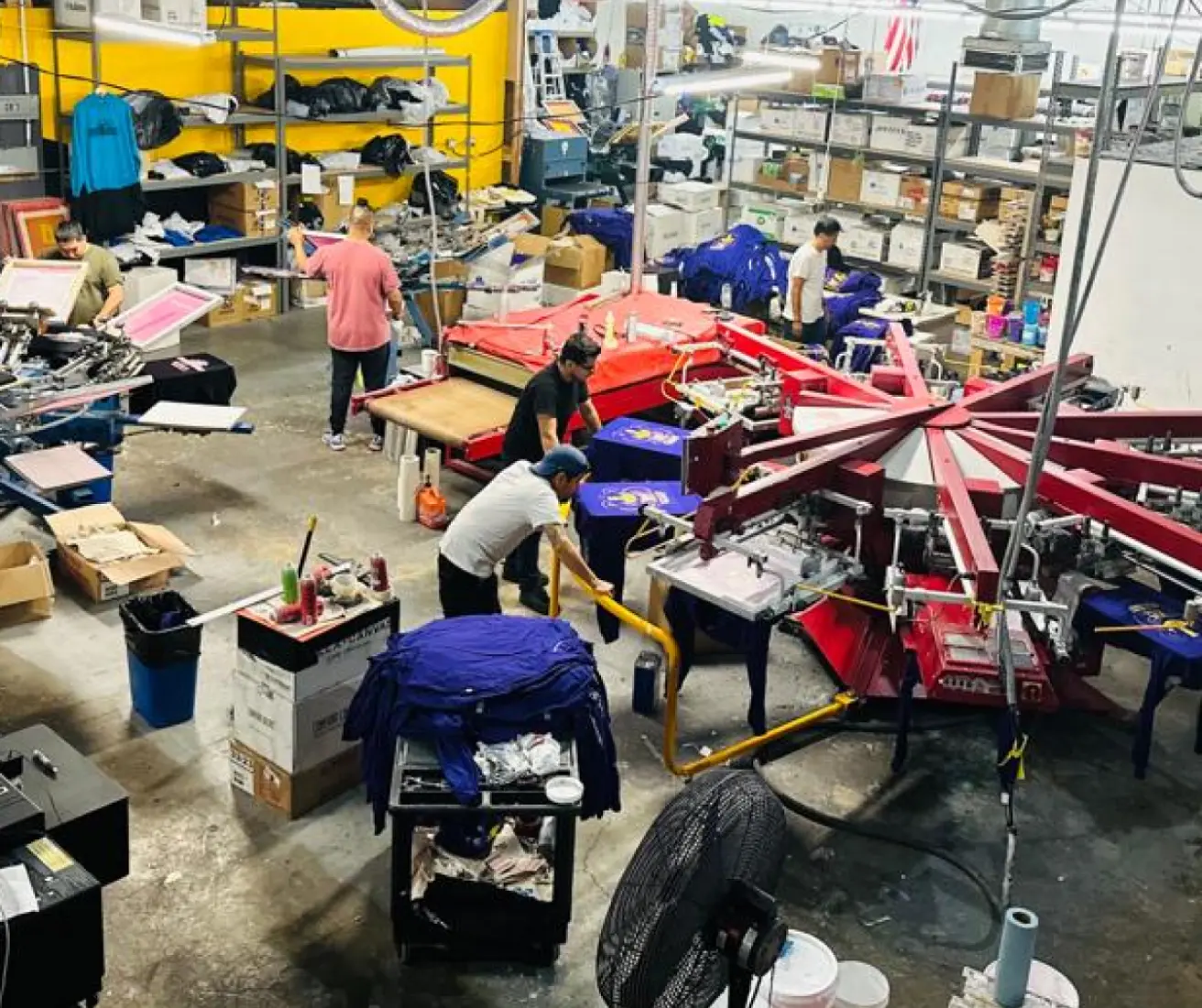Display Printing Uncovered: Whatever You Required to Learn About T-Shirt and Garment Printing Strategies
If you have actually ever before questioned how those vivid styles end up on your preferred t-shirts, you remain in the right place. Display printing is a remarkable technique that integrates art with method, offering unlimited possibilities for imagination. Comprehending the principles, from devices to ink options, can considerably impact your outcomes. All set to explore the essential elements that make display printing an art type? Let's discover the details that can elevate your projects.
The Essentials of Display Printing: How It Works
When you dive into display printing, you'll discover it's both a scientific research and an art. At its core, screen printing involves developing a stencil, or screen, that permits ink to pass through just in details locations.
Position the screen over the material, then use a squeegee to press ink through the display onto the garment. Each step is crucial, and grasping them will certainly raise your display printing skills, changing straightforward garments into unique, meaningful items.
Kinds Of Screen Printing Techniques
Once you grasp the fundamentals of display printing, it's time to check out the numerous techniques that can raise your layouts. One prominent technique is traditional display printing, where ink is pressed through a stenciled display. This technique is great for strong, dynamic colors. There's water-based ink printing, which provides a softer feeling and is environment-friendly, but it requires a different method to treating.
If you're going for fine information, consider discharge printing. This method removes dye from the material, leaving a soft, classic look. Another alternative is plastisol printing, known for its toughness and dazzling colors, making it a favored for several brands. Experiment with halftone printing to create slope impacts and complex styles. Each technique has its unique beauty, so don't be reluctant to try them bent on discover what suits your design best!
Essential Tools for Display Printing
To accomplish spectacular results in screen printing, having the appropriate equipment is basic. First, you'll require a durable display printing frame, which holds the mesh that transfers your layout onto the garment. Next, purchase premium squeegees; these are essential for using ink equally across the screen. You'll additionally require a great exposure unit to develop your screens, as well as a washout booth for cleaning them after usage. A trustworthy warm source, like a conveyor dryer or warmth press, is vital for curing your prints to ensure longevity. Don't neglect a proper office, geared up with tables and storage space for your supplies. Ultimately, protective gear, such as masks and gloves, will certainly keep you secure from chemicals and inks. With the right devices, you'll be well on your way to creating professional-quality prints.
Picking the Right Inks and Products
When picking inks and products for display printing, you require to take into consideration the kind of ink that functions finest for your task. Assume concerning fabric compatibility to ensure your styles look terrific and last long. Additionally, discover eco-friendly ink alternatives to make your printing procedure more sustainable.
Types of Screen Inks
Selecting the right display ink is important for achieving vivid, durable prints that fulfill your project's requirements. There are numerous types of screen inks to check out. Specialty inks, such as metal or glow-in-the-dark, can include special effects to your layouts.

Fabric Compatibility Factors To Consider
Understanding material compatibility is important for achieving high-grade display prints, particularly because various materials respond uniquely to different inks. When picking inks, think about the textile kind-- cotton, polyester, or blends. For cotton, water-based inks function well, using gentleness and breathability. Polyester, on the other hand, commonly calls for plastisol inks for far better adhesion and lively shades. If you're printing on blends, you may require to make use of a mix of both kinds. Always test your inks on example textile to assure they stick effectively and keep shade honesty. Furthermore, maintain in mind that fabric weight and appearance can influence the last outcome, so selecting the best ink and material combination is important for your task's success.
Eco-Friendly Ink Options
Eco-friendly inks are becoming a prominent option for screen printers that desire to decrease their ecological impact while maintaining quality. When choosing inks, take into consideration water-based inks, which are much less damaging and much easier to cleanse up contrasted to standard solvents.
In addition, search for inks made from renewable energies, such as soy or vegetable-based choices. By selecting the best inks and materials, you'll not only create sensational layouts yet additionally add to an extra sustainable printing process. Make the switch, and your prints will reflect your commitment to the atmosphere!
Preparing Your Style for Screen Printing

Submit Layout Requirements
To assure your design looks sharp and vivid on material, you'll require to pay close attention to submit format demands for display printing. Start with vector data like AI or EPS, as they can be scaled without shedding quality. If you utilize raster photos, select high-resolution documents, such as TIFF or PNG, preferably at 300 DPI. Avoid making use of JPEGs, as they can lose clarity when resized. Additionally, ensure your layout has a clear background to stop undesirable white edges on your prints. Maintain shade modes in mind; CMYK is typical for display printing, so convert your RGB creates accordingly - screen printing kit. By complying with these standards, you'll set your artwork up for a successful print.
Color Separation Strategies
Shade separation is a necessary step in preparing your design for display printing, and understanding it can greatly boost your print top quality. You'll require to break your design into specific shades, as each color requires a different display during printing. Start by identifying all the colors in your layout and develop layers for each one. You can use software like Adobe Photoshop or Illustrator to separate and separate colors effectively. Be particular to conserve each layer as a separate documents, typically in a layout like TIFF or PSD. This accuracy not only guarantees exact shade representation yet likewise improves the printing procedure. By taking notice of color splitting up, you'll accomplish dynamic and professional cause your screen-printed garments.
Resolution and Size
Achieving the most effective results in screen printing begins with ensuring your layout has the best resolution and dimension. Ideally, your artwork needs to be at least 300 DPI (dots per inch) for sharp, clear prints. Your last product could look pixelated and unprofessional. if you utilize reduced resolution.
When it comes to size, take into consideration the dimensions of your print location. Style your art work to match the last print size, visit this site right here ideally developing it in the actual measurements you'll find out here be publishing. This method, you'll stay clear of any type of unexpected scaling issues.
Always inspect your layout in both vector and raster layouts. Vector graphics can be scaled without losing quality, making them excellent for screen printing. Preparing correctly will ensure your style looks remarkable on every garment!
Step-by-Step Screen Printing Process
Display printing is a dynamic procedure that permits you to develop vivid layouts on different surfaces. To get started, you'll require a display, emulsion, and your chosen ink.
Put ink onto the display and use a squeegee to press the ink with the stencil onto the material. Lift the display thoroughly and allow the print completely dry. You've effectively screen published your design.
Tips for Effective Screen Printing Projects
While you're diving right into your screen printing tasks, keep in mind that preparation is crucial to success. Start by collecting all your materials-- inks, displays, squeegees, and garments. A tidy work area aids avoid undesirable errors, so clean up before you start.
Next, confirm your art work is high-resolution and appropriately sized for your garment. Test your display for correct exposure and tidy it thoroughly to prevent spots. When mixing your inks, comply with the manufacturer's guidelines to attain the appropriate consistency.
Throughout printing, use even pressure with your squeegee for regular results. Don't hurry; take your time to validate each print meets your criteria. After printing, let your garments dry entirely before managing or packaging them.
Last but not least, always maintain an example of your work for future recommendation. In this manner, you can evaluate your development and boost your techniques in time. Satisfied printing!

Regularly Asked Questions
How much time Does It Take to Establish a Screen Printing Job?
Setting up a screen printing task commonly takes around half an hour to an hour. You'll prepare the displays, mix inks, and change journalism. The time differs based on complexity and experience, so remain arranged!
Can I Publish on Various Textile Types Utilizing the Exact Same Strategy?
Yes, you can publish on various textile types utilizing the exact same technique, but you'll need to readjust your settings and inks. Some fabrics take in ink in different ways, so trying out warranties the very best results for each and every product.
What Are Common Mistakes to Prevent in Screen Printing?
When display printing, prevent common blunders like utilizing the wrong ink, neglecting proper exposure times, or skipping pre-press checks. Constantly test your setup and keep tidy screens to ensure quality results Web Site each time.
How Can I Correctly Clean and Preserve My Screen Printing Equipment?
To appropriately clean and maintain your display printing devices, you ought to frequently wash displays with appropriate solvents, inspect mops for wear, and guarantee all devices are saved dry and dust-free. Consistency improves and protects against costly repair services efficiency.
Is Screen Printing Eco Friendly Contrasted to Other Techniques?
Display printing can be a lot more eco-friendly than other techniques, specifically if you utilize eco-conscious products and water-based inks. By choosing lasting materials and techniques, you reduce waste and lessen your effect on the earth.
Screen Printing Uncovered: Every Little Thing You Required to Know Concerning Tee Shirt and Garment Printing Methods
At its core, screen printing entails producing a stencil, or display, that permits ink to pass via just in particular locations. Setting the display over the textile, after that use a squeegee to push ink with the screen onto the garment. One prominent approach is typical display printing, where ink is pressed via a stenciled display.When picking inks and products for display printing, you need to take into account the type of ink that works finest for your job.
Comments on “Best Local T-Shirt Printing for Personalized Apparel”